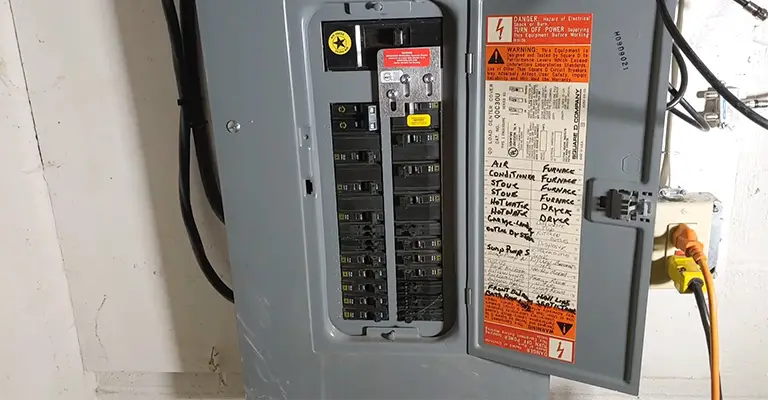In times of power outages or emergencies, having a reliable backup power source can be a real lifesaver.
A generator can provide electricity to keep essential appliances and systems running, ensuring your comfort and safety until the main power supply is restored.
One standard method for distributing generator power throughout your home is by backfeeding your breaker panel.
Backfeeding involves connecting your generator directly to your breaker panel, allowing it to supply electricity to the circuits within your home.
While this method can be convenient, it requires careful attention to safety guidelines and proper installation procedures.
Incorrectly backfeeding your breaker panel can pose serious risks, such as electrical shock, fire hazards, and damage to your electrical system.
Backfeeding refers to powering an entire house with a portable generator when a power outage occurs. When an outage occurs, this is a dangerous substitute for safer methods of powering your home.
Generator Backfeeding & Its Dangers Explained
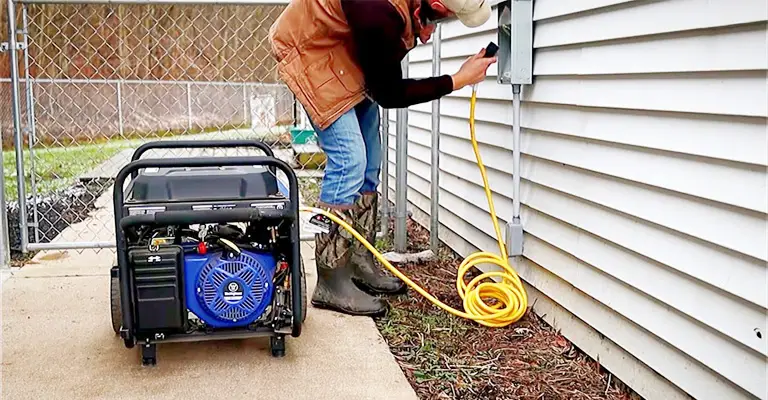
Most jurisdictions declare back feeding a generator illegal as it is a dangerous practice. Similarly, businesses and apartments follow the same rules.
People who backed their houses connected their generators to an outlet with a homemade cord with two male plugs.
Electricity enters the main panel through the branch circuit breaker on the outlet using a Generator Backfeed Cord, sometimes called a suicide cord.
Power is distributed throughout the home through the other branch circuit breakers on the panel.
Furthermore, power is fed through the main breaker to the transformer, which then converts it back to thousands of volts and tries to energize all neighborhood utility lines.
The act of energizing utility lines in this manner is dangerous and illegal. High voltage on the utility lines could cause fatal shock to workers trying to restore power to the neighborhood.
The hazard is alleviated by turning off the main breaker, but it relies on someone turning it off. It is unlikely that someone else will turn the main breaker back on and energize the neighborhood wires.
There is no safeguard against accidentally energizing utility lines or introducing a hazard of electrocution within the home with this arrangement.
It is possible to electrocute yourself when using a generator back feed cord. There are 240 volts across each cord terminal if a plug inside the house falls out or is pulled out of the appliance outlet.
Electric shocks can occur to anyone who trips over the cord or stumbles into it. As a result, this cord is appropriately known as the Generator Suicide Cord.
The convenience outlet is usually connected to other outlets and fixtures. When a generator is plugged into a convenience outlet, all the outlets will be energized without a circuit breaker to protect them.
It is possible to start a fire because the wires overheat, even if the circuit breaker in the panel has tripped.
Illegal Backfeeding
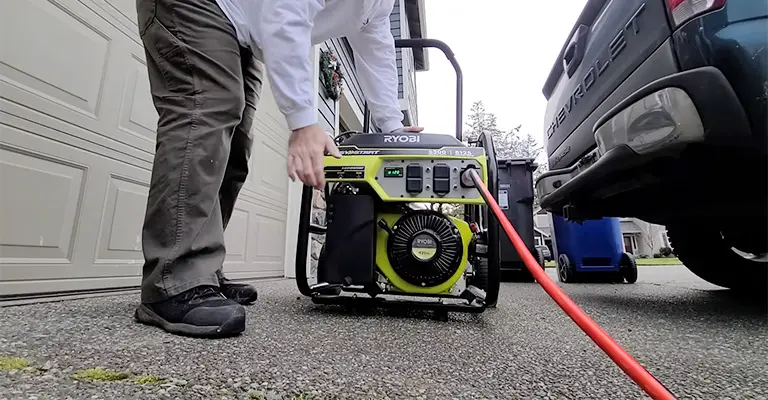
Most countries consider back feeding illegal and dangerous. In this case, the National Electrical Code is violated.
The punishment for backfeeding your electrical system, resulting in injury or death to anyone or injuring or killing others, is very real, and you face criminal prosecution.
Even if your actions do not injure anyone, if the utility finds that you are back feeding their lines, you may face fines or an interruption of service.
You may lose your homeowners insurance if you injure or kill someone by backfeeding.
It is your responsibility to take care of any liability that may arise if this occurs. A local community or authority overseeing building codes and enforcement may also fine you.
Maintain a safe environment and avoid problems. If a power outage occurs in the near future, you can install a manual transfer switch or hire a qualified electrician to handle the job.
Risking your life is not worth the danger. Essentials such as refrigerators, furnaces, and sump pumps can be given reliable power using a manual transfer switch.
Poor Power Management
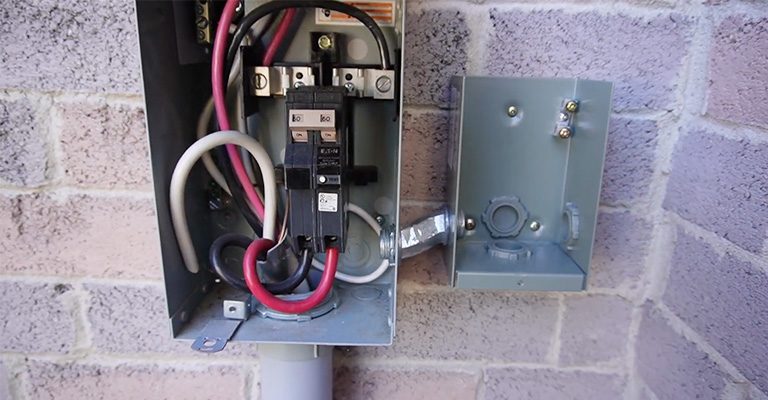
By backfeeding a service panel, the entire circuit breaker panel is energized. In the panel, power is distributed on all circuits throughout the house.
It is only possible to supply enough power for an entire home with a portable generator that is large enough. The issue can be resolved by turning off some breakers, which will not balance the loads.
240 volts are supplied from the generator via two 120-volt lines. The generator’s capacity is split between the two lines.
Unbalanced loads push the generator to its limits, and the home can only use half its capacity if most or all circuits are on the same line.
Safer Alternative
Using a portable generator to power your home is safer with a manual transfer switch. The generator power is connected to the household electrical system through a manual transfer switch before connecting to the utilities.
During installation, the homeowner selected the branch circuits that would receive electrical power from the switch.
There are separate breakers for each circuit, and electrical power is not allowed to leave the residence.
Due to this, there won’t be any possibility of powering neighborhood utility lines or endangering workers.
A transfer switch protects a generator from damage caused by the sudden introduction of another power source when the utility restores power.
As a result of the transfer switch, the generator load is distributed evenly among the two 120-Voltage lines.
Using a balanced load puts less strain on generators, fuel is saved, and the generator’s capacity is fully utilized.
How to Connect a Transfer Switch?
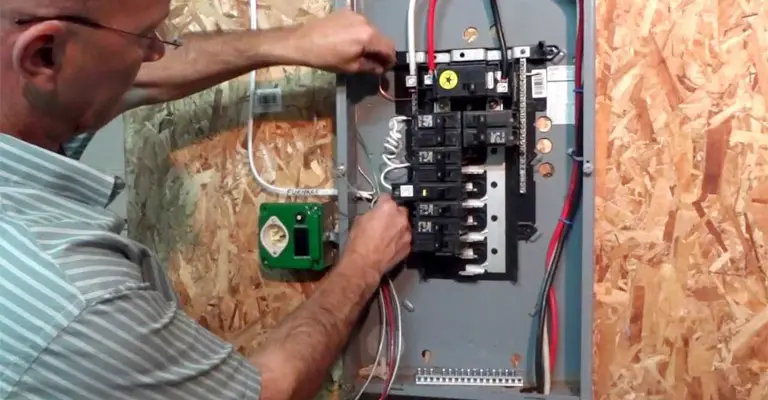
Getting a transfer switch connected involves several steps, and following the manufacturer’s instructions is essential. If you need help installing the switch or need to ensure it is installed correctly, contact a licensed electrician.
This article will cover the steps involved in connecting a transfer switch.
Disconnect the power supply to the building by switching off the main circuit breaker in the electrical panel.
Ensure the transfer switch is placed close to the electrical panel and easily accessible. The transfer switch must be grounded and installed in compliance with local electrical codes.
Attach the backup power source, such as a generator, to the transfer switch. The power cord of the generator may need to be connected to the power inlet box.
Make sure the transfer switch is connected to the building’s electrical panel. During this process, wiring has to be run from the transfer switch to the electrical panel and then connected to the appropriate circuits.
You should test the transfer switch to ensure that it is functioning properly.
In this case, it may be necessary to simulate an outage by turning off the generator and verifying that the transfer switch automatically switches the electrical load to the utility.
Ensure which circuits are connected to the backup power source on the transfer switch and electrical panel.
Working with electrical power while connecting a transfer switch can be dangerous if not done correctly.
If possible, consult a licensed electrician who can ensure that the transfer switch is installed safely and in compliance with local laws.
How To Backfeed A Breaker Panel With A Generator?
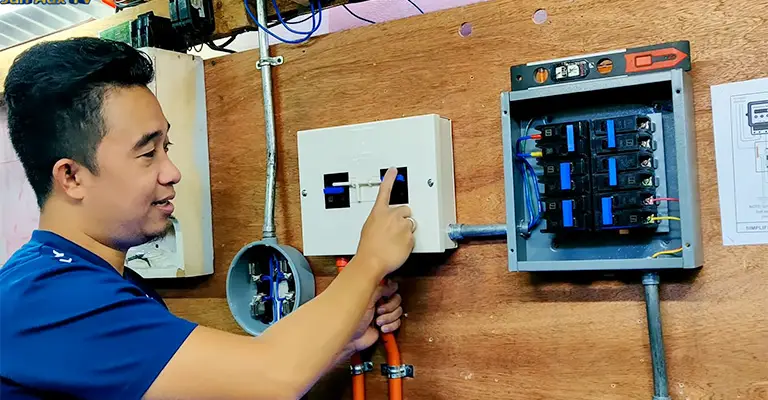
The use of a generator to back-feed a breaker panel is illegal and dangerous. The switch must be installed, or other appropriate equipment must be used. Utility workers and others can be exposed to hazardous conditions when this occurs.
To safely connect a generator to a building’s electrical system, use a transfer switch (interlock kit) or other device designed for this purpose.
Basically, a transfer switch isolates the generator’s electrical output from the utility lines. Backfeeding is prevented; only one power source is connected to the electrical system at a time.
A transfer switch is normally installed between the main breaker panel and the generator, making switching between the two power sources easy.
To back feed a breaker panel with a generator using a transfer switch, follow these steps:
- Ensure the transfer switch you purchase and install is compatible with your generator. The main breaker panel can be installed yourself if you have experience working with electricity.
- It is recommended that you contact a professional (a licensed electrician) for most users.
- The main breaker in your electrical panel must be turned off. By using the appropriate cables and connectors, connect the generator to the transfer switch.
- You should allow the generator to warm up after you turn it on. If your transfer switch comes with instructions, turn on the circuits you want to power one at a time.
- When you are ready to go back to utility power, turn off all the circuits you powered with the generator and also turn off the generator. You should switch the transfer switch to the utility power position and turn on the main electrical panel breakers.
The following steps will guide you through the process of backfeeding a breaker panel with a generator using a transfer switch safely and legally.
Dangers of Backfeeding Without Transfer Switch
Significant dangers are involved in backfeeding a breaker panel with a generator without a transfer switch, resulting in serious injury, property damage, or even loss of life.
Some of the most significant risks associated with back feeding without a transfer switch are listed below.
When electricity flows in both directions, it can cause electrocution if someone comes into contact with the power lines and electrical system.
Utility workers who work on power lines or try to restore power to the area might face severe injuries if not death, if the power lines are hit by lightning.
There is a possibility that backfeeding could overload the electrical system and cause overheating and fire in wires and other electrical components.
In addition to causing property damage, it can also cause health issues. Electrical equipment, appliances, and other electronic devices may be damaged if backfeeding occurs within a home or building.
A backfeeding incident can result in fines, legal action, and even criminal charges.
Backfeeding can pose serious risks, so using the right equipment and safety measures is vital to avoid them. Connecting your generator safely and legally can be made easier with the help of a licensed electrician.
Why People Backfeed Breaker Panels With A Generator?
It is common practice to back-feed generators during a power outage to provide temporary power for homes and businesses.
The backfeeding method involves hooking up a portable generator directly to an electrical outlet or circuit in a building rather than using a transfer switch or other safety device.
Because the dryer plug is usually the largest in a typical residential electrical system, connecting the generator’s outlet directly to the dryer plug is the most common way to back feed a generator.
There are many dangers associated with this approach, so we do not recommend it. It is often more cost-effective to back feed a generator rather than use a transfer switch for several reasons:
Some people may choose to back-feed their generator instead of installing a transfer switch because of the cost.
A backfeeding generator has the advantage of being able to be connected to one outlet or circuit rather than requiring multiple circuits.
Occasionally, a transfer switch will not be available or may not be compatible with the electrical system in a building.
However, back feeding can be hazardous if not performed correctly. Besides putting people at risk of electrocution or fire, it can damage electrical equipment or cause power outages.
Final Words
With the weather becoming more unpredictable every day (as illustrated by the recent Los Angeles floods), portable generators are increasingly in demand. Proper use of a portable generator is as important as purchasing the generator itself.
In most generator owners’ minds, the question is, “How do I back feed a breaker panel with a generator? Directly feeding a generator to the main breaker is extremely dangerous and also illegal.
A transfer switch or interlock kit must be used to connect a generator to the main breaker panel.

